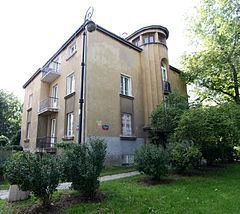 | ||
Restaurants Dom Polski, Pikanteria, Naam Thai, Think Love, Kuchnia Funkcjon | ||
Saska Kępa ([ˈsaska ˈkɛmpa]) is a neighbourhood in Warsaw, Poland, part of the Praga Południe district. It is also the home to one of Warsaw's largest urban parks, the Park Skaryszewski.
Contents
Map of Saska K%C4%99pa, Warsaw, Poland
History
In the seventeenth century an area ofher stal the (eastern) bank of the Vistula River opposite Warsaw was turned into a military camp. This area became known as Saska Kępa ('Saxon meadow') after the Saxon Guards of the Kings of Poland stationed there in the eighteenth century. The area retained its rural character until the early twentieth century. It officially became part of the city of Warsaw in 1916, and quickly became one of the fastest-growing areas of the city. During the 1920s and 1930s members of Warsaw's growing middle class built mansions in the suburb and the area became a popular residential area.
The location of Saska Kępa on the east bank of the Vistula, allowed the district to escape the systematic destruction inflicted during and after the Warsaw Uprising of 1944. The area also largely escaped urban redevelopment by communist authorities after World War II, despite several plans to industrialise it. This allowed the suburb, now a district of Praga Południe to retain much of its original peaceful character. It has historically housed many foreign embassies and consulates, nestled among streets that were named in the 1920s after continents, nations, and major world cities.
Ulica Francuska is today the main commercial street, and is lined with shops and increasingly large numbers of restaurants.
The "front door" to the district is Rondo Waszyngtona, a roundabout named after George Washington, which links the suburb via the Poniatowski Bridge to the Warsaw city center by road and tram. The north side of the roundabout hosts the Polish National Stadium, formerly the 10th Anniversary Stadium.
Several controversial apartment complexes have sprung up within Saska Kępa, but no further major construction projects are being considered for fear they would damage the unique character of the area. Many of the older homes in Saska Kępa were remodelled in the late 1990s and early 2000s, but most were restored in manner consistent with the pre-World War II character of the district.
